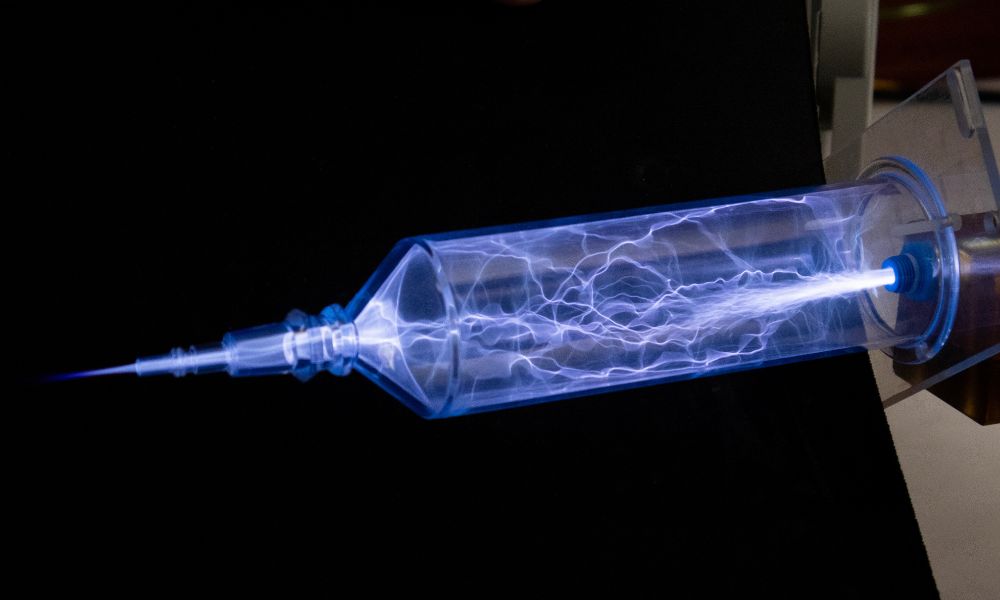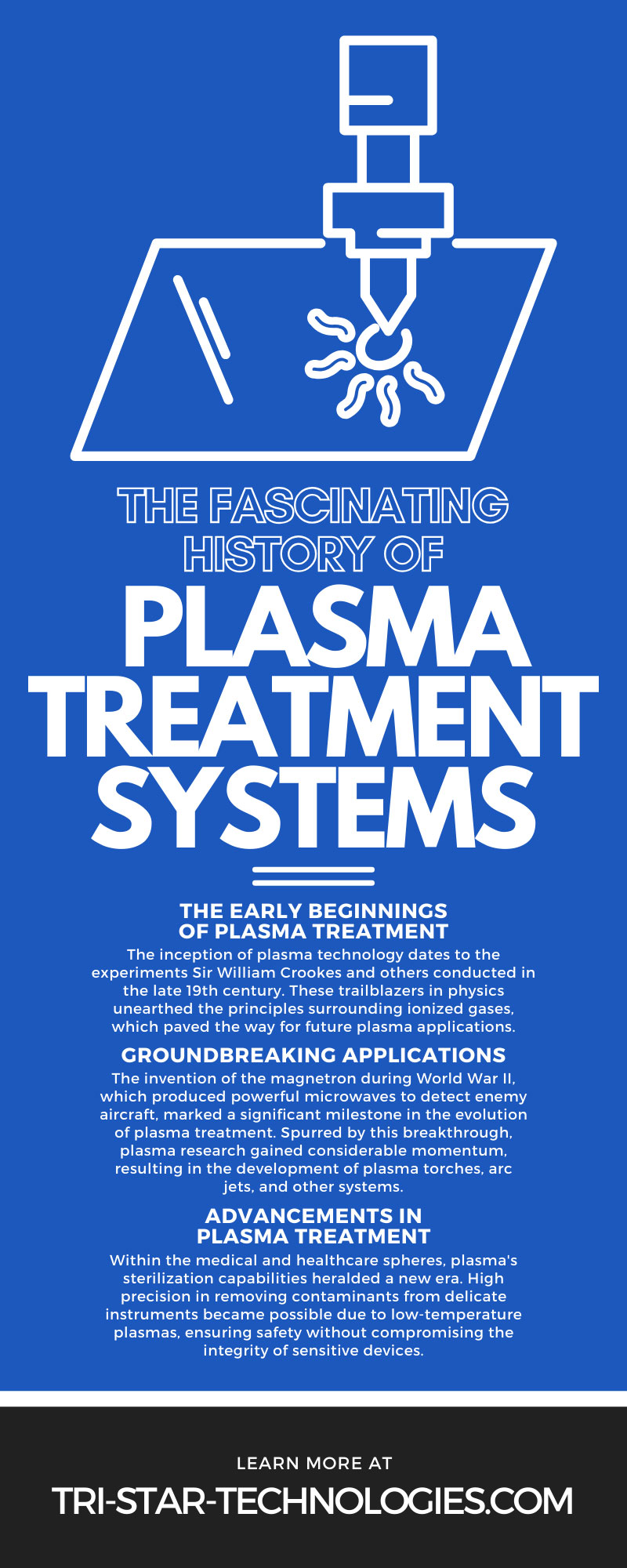The Fascinating History of Plasma Treatment Systems

In the annals of scientific and technological advancement, few innovations can boast the transformative power of plasma treatment systems. The modern plasma treatment system that engineers and lab developers can find at Tri-Star Technologies has a fascinating history that dates back over a century. We’ll go through the history of plasma treatment, from its humble origins to its key innovations and explosion of applications in various industries in our current world.
What Are Plasma Treatment Systems?
Before entering their history, what exactly is a plasma treatment system? These systems fundamentally leverage the unique properties of plasma—a highly energetic state of matter where ions and electrons coexist—to modify the surface characteristics of materials for an array of industrial applications. These systems emit a plasma cloud that can clean, activate, etch, or coat surfaces, enhancing their wettability to ensure stronger bonding and better adhesion.
With a broad spectrum of applications, from etching fine circuitry onto semiconductor wafers to improving the adhesion properties of medical devices, plasma treatment is critical in sectors demanding the utmost precision and reliability, like aerospace, automotive, electronics, and biomedicine.
The Early Beginnings of Plasma Treatment
The inception of plasma technology dates to the experiments Sir William Crookes and others conducted in the late 19th century. These trailblazers in physics unearthed the principles surrounding ionized gases, which paved the way for future plasma applications. Fundamental to their research was the understanding that plasma could be generated by subjecting gases to high energy or electromagnetic fields, leading to the ionization of atoms and the resultant exotic state of matter. The advent of vacuum technology in the early 20th century would enhance our understanding of plasma and its properties.
Groundbreaking Applications
The invention of the magnetron during World War II, which produced powerful microwaves to detect enemy aircraft, marked a significant milestone in the evolution of plasma treatment. Spurred by this breakthrough, plasma research gained considerable momentum, resulting in the development of plasma torches, arc jets, and other systems. In 1951, IBM engineer Simon Ramo observed that a discharge from a high-frequency capacitor produced an etch on aluminum surfaces—this heralded the arrival of plasma processing in integrated circuit fabrication. This discovery revolutionized the electronics industry and propelled plasma technology to mainstream use.
Advancements in Plasma Treatment
As the understanding of plasma grew more sophisticated, so did its applications. In the industrial realm, plasma treatment became an indispensable tool for surface activation, increasing adhesion properties significantly, which was critical for product manufacturing and material processing. The technique’s versatility allowed efficient processing of materials like polymers, metals, and ceramics. Subsequently, the development of atmospheric pressure plasma systems spurred advancements in biomedical engineering, where they are used to coat medical implants with biocompatible materials or sterilize medical equipment.
Within the medical and healthcare spheres, plasma’s sterilization capabilities heralded a new era. High precision in removing contaminants from delicate instruments became possible due to low-temperature plasmas, ensuring safety without compromising the integrity of sensitive devices. Furthermore, plasma treatment has become a staple in the electronics industry for creating delicate circuitry patterns on microelectronic devices.
Plasma Treatment as a Green Alternative
Environmental applications unfolded with plasma’s capability to treat waste and reduce pollutants, offering cleaner and greener alternatives to traditional processes—underscored by the industry’s ongoing search for sustainable practices. The future of plasma treatment promises to be even more exciting, with ongoing research on carbon-neutral plasma technologies and their use in space propulsion.
Key Innovations
Technological breakthroughs have punctuated the history of plasma treatment. The advent of atmospheric plasma systems marked a paradigm shift, enabling plasma’s deployment outside vacuum environments, thus expanding its applicability exponentially. Industrial corporations have since seamlessly integrated plasma processes into production lines.
The ability to manipulate the characteristics of plasma through frequency, power modulation, and gas composition has allowed engineers and scientists to target specific treatment outcomes. This bespoke approach has proven indispensable in semiconductor manufacturing to aerospace engineering scenarios.
Plasma Treatment for Pharmaceuticals
Presently, plasma treatment systems are vital in the realm of pharmaceutical engineering. The precise control offered by plasma processes is crucial for optimizing container surfaces, ensuring the stability and longevity of pharmaceutical products. From improving the wettability of packaging materials to activating syringe surfaces, plasma technology underlies many aspects of pharmaceutical manufacturing.
Other Modern Applications for Plasma Treatment
In today’s competitive landscape, industries such as electronics, automotive, and textiles are relentlessly pursuing innovations that can distinguish their products with superior quality and performance. For the electronics sector, plasma treatment systems are indispensable for the precise etching required in circuit board manufacturing, ensuring the high-fidelity transfer of intricate designs necessary for advanced microelectronics.
In automotive manufacturing, adhesion improvement gained through plasma processes is essential for the durability of components exposed to extreme environmental conditions, from the vehicle exterior to the electronic systems within. Similarly, the textile industry benefits from plasma’s ability to alter the surface energy of fibers, achieving enhanced dye-uptake properties and enabling the production of materials with improved stain resistance and water repellency. Our solutions are at the forefront of these processes, employing state-of-the-art plasma systems that cater to the nuanced requirements of each industry with unmatched precision and reliability.
The Future of Plasma Treatment
As we gaze toward the horizon, plasma treatment systems promise further innovation and integration into yet-to-be-imagined applications. The growing interest in plasma’s role in energy generation and propulsion, particularly in aerospace applications, suggests a leading edge for this technology.
Emerging trends indicate a surge in the adoption of plasma-enabled 3D printing and additive manufacturing, which offer heightened precision and material properties that were previously unattainable. The synergy of plasma with nanotechnology also hints at a future that profoundly affects the very fabric of materials science.
Get on the Cutting Edge of Plasma Treatment With Tri-Star Technologies
The fascinating history of plasma treatment systems is replete with ingenuity, discovery, and boundless potential. This narrative underscores humanity’s relentless pursuit of knowledge and mastery over the elements. As we have traversed from the nascent stages of plasma research to its proliferation across a myriad of industries, the impact of this technology is undeniable.
As a frontrunner in this space, Tri-Star Technologies remains committed to furthering the efficacy and reach of plasma treatment systems. If you want to learn more about plasma treatment machines or think your process could benefit from surface cleaning and activation from plasma treatment systems, contact our expert staff today.



